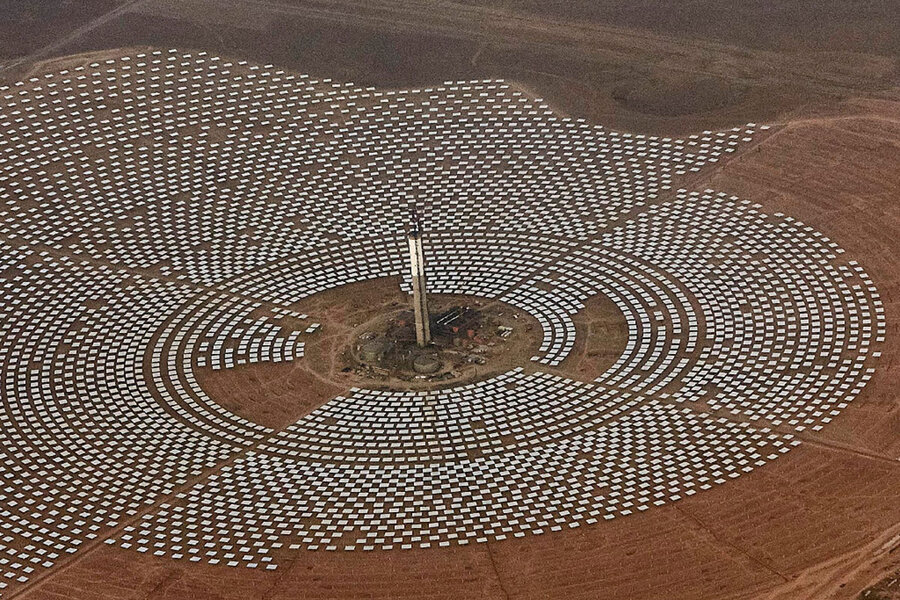'More for less': Renewable power surges into mainstream as costs fall
Loading...
Solar panels and wind turbines are often seen as a luxury that only a small amount of the world can consider as a way to generate electricity.
But renewable energy may no longer be niche.
In 2016, world markets added a record 138.5 gigawatts of renewable power capacity, according to an annual report from the United Nations Environment Programme (UNEP). And remarkably, that record growth came with a decline in investments, a sign of declining costs that has led some industry analysts to suggest that the once-fringe industry has gathered enough momentum to weather shifting political winds.
“Renewable energy is here to stay and to grow,” says Françoise d'Estais, head of the Energy and Finance Unit of the Energy, Climate and Technology Branch of the UNEP and one of the study authors. “It's becoming mainstream.”
The report describes 2016 as a year of “more for less” in renewable energy investments. Wind, solar, biomass and waste-to-energy, geothermal, small hydro, and marine power provided 11.3 percent of global electricity in 2016, up from 10.3 percent in 2015, even as the dollar figure of new investment in renewables fell by 23 percent from 2015 to 2016.
Angus McCrone, lead author of the report and chief editor of Bloomberg New Energy Finance, attributes much of the dip in investment to decreases in cost and increases in efficiency.
Onshore wind technologies, for example, currently produce a quarter of the theoretical maximum of power that they are thought to be able to generate, twice the 12 percent seen in 1997. And the cost of the actual equipment has gone down, too, as manufacturers have figured out how to reduce waste during production.
Competition is also helping to drive costs down, both in the manufacturing supply chain and on the development end of the process, Mr. McCrone says.
Competition at energy auctions pushed renewable-generated power contracts to record lows in 2016. For example, at an auction in Chile, a developer won a contract to sell solar-generated power at $29.10 per megawatt-hour, nearly half the price of coal power sold at the same event.
The dip in investments can’t be solely chalked up to declines in cost, however. Some key markets saw significant reductions in investments, particularly in developing countries. Investment in renewables in China, for example, fell by 32 percent in 2016 – the first time in 11 years that such investment fell in that nation.
One challenge in expanding renewable electricity generation capacity is that it requires new installations, when fossil fuel power plants are already up and running.
"There's a stock of generating capacity already in place and, unless it's being retired because it's too old, it will remain in place," points out Charles Kolstad, an environmental economist at Stanford University who was not involved in the report. And much of that fossil fuel capacity could continue to run for decades.
Furthermore, renewables aren't the only power sources being installed around the world.
“Some of the countries where electricity demand is growing the strongest, India and southeast Asia particularly, are going to go on building more coal-fired power stations for a considerable time because coal is cheaper,” McCrone says.
That could mean trouble for efforts to cut carbon dioxide emissions, as coal is the most carbon-intensive source of power generation, according to the International Energy Agency (IEA). The UNEP-backed report estimates that renewable power sources prevented some 1.7 gigatons of CO2 in 2016.
Because of the continued installation of fossil fuel power plants, McCrone says, “we think that emissions in 2040 will be a little bit higher than they are now worldwide.”
Achieving the goal of halting global warming before it hits 2 degrees Celsius (3.6 degrees F.) above preindustrial levels, would require about $1 trillion worth of investments in renewable energy, Barbara Buchner, executive director of the climate finance program at the Climate Policy Initiative who was not involved in the report, says, citing IEA estimates.
Getting investment anywhere near that level would take significant buy-in from both world governments and the private sector, Dr. Buchner says. Global nations made some commitments to that end as part of the landmark Paris agreement. Those commitments are voluntary, however, and subject to political shifts, as seen in the United States with the arrival of President Trump.
The good news, Buchner, Kolstad, and McCrone agree, is that the business sector is already on board and appears willing to step in where governments leave off.
Where renewable markets once relied heavily on government subsidies to remain competitive, “I think the market is taking over a lot of what governments used to do,” says Kolstad. But he adds that withdrawing policy support entirely could slow the momentum.
But as renewable technologies approach cost-competitiveness (McCrone estimates that wind and solar could become the cheapest available option by the 2020s in some countries), an increasing number of big industry players have already made strategic investments into renewables as part of their diversified portfolios.
Companies see the declining cost of renewables as an opportunity, Buchner says. As such, “the energy transition is irreversible.”






